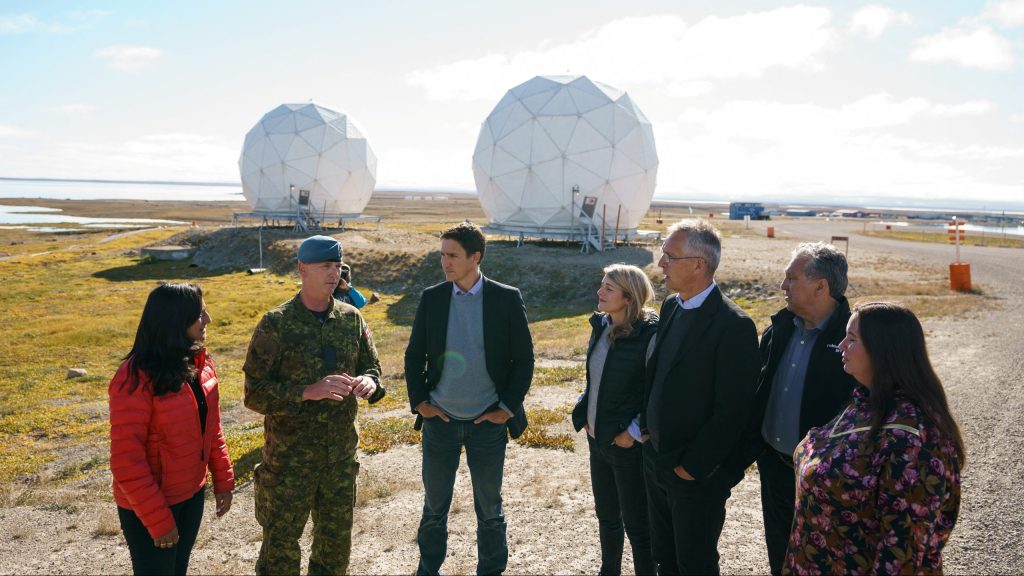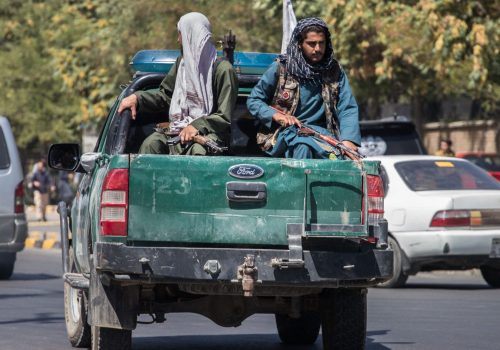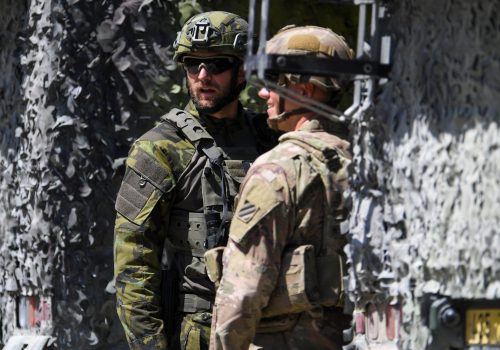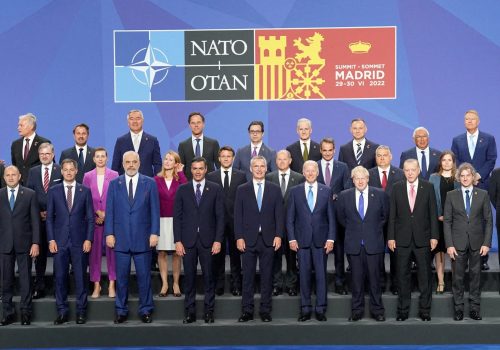Six months in, Russia’s war on Ukraine has prompted unprecedented unity among the transatlantic allies. This cohesion has been admirable, but it should not be taken for granted. The crisis is also an opportunity to upgrade the transatlantic architecture—since it is unlikely that the current cohesion will endure unless consolidated institutionally. The energy to carry through long-needed upgrades may have finally materialized, but it will take transatlantic leadership to step back from crisis management and see this effort through to fruition.
At the start of the Cold War, officials on both sides of the Atlantic used the crisis as a catalyst to develop joint organizations that, in turn, perpetuated the spirit of transatlantic cooperation. They created a strong NATO, institutionalizing strategic unity across the Atlantic. They formed the Atlantic Treaty Association to build grassroots support for an Atlantic community overall, but for the Alliance in particular. Atlantic-Pacific alliances followed, such as the Organization for Economic Cooperation and Development (OECD) and Group of Seven (G7) nations, in line with Article 2 of the NATO Treaty calling for additional steps to strengthen allied economic and political cooperation and safeguard “peaceful and friendly international relations.” The crisis of that time was not allowed to go to waste.
Today, Atlantic leaders should treat the current war in Ukraine—the greatest crisis in European security since the end of the Cold War—as a similar opportunity to upgrade institutional capabilities. The fact that efforts to deter the war failed demonstrates an urgent need to study the shortfalls of existing institutions, improve them, and redefine the way they interact to better fit an increasingly challenging security environment.
While the unprecedented sanctions and NATO’s new Strategic Concept both show strong resolve, questions remain in Atlantic circles about whether the allies have the staying power to follow through on these over the longer term. This will require tangible actions to strengthen the institutional capacities for maintaining cooperation. Transatlantic leaders must do the most institutional enhancement they can get done in this crisis—not the least they can get away with.
Anyone who cares about the future of the Alliance should use this opportunity to think about specific improvements and implement them. To start, here are several ideas for moving the alliance system forward, starting with the easiest and working upward:
The G7 and OECD
One of the more promising developments in the immediate aftermath of Russia’s war on Ukraine was the increased collaboration among the traditional Atlantic institutions. This was most apparent in June, with the G7 and NATO summits happening in close succession and with overlapping agendas. Going forward, the G7 is well-positioned to spearhead increased linkages among the Atlantic institutions. It has already invited representatives from NATO to its recent crisis meetings; it can now add NATO to its standard invitation list.
In the face of malign Chinese and Russian uses of their economic influence and the growing policy focus of its major members on supply chains and sanctions, the OECD may find that it needs to do more on economic aspects of security. A more continuous NATO-OECD dialogue would be helpful here; the OECD could establish a liaison office at NATO, and vice versa. Fortuitously, a regular OECD-NATO link would also provide an additional channel for NATO to engage with its Pacific partners.
With the G7 already receiving OECD input to its working groups, this closer networking of the three main bodies of the Atlantic-Pacific family of institutions—NATO, OECD, and the G7—would be a healthy step forward for the international system.
Forming new functional structures
Atlantic institutions have always filled in for global institutions when the latter fall short, as they inevitably sometimes will because of large and diverse memberships that make agreement at scale around divisive issues impossible.
The “outer” global institutions—the United Nations (UN), World Health Organization (WHO), the International Atomic Energy Agency, and the World Trade Organization—serve an invaluable purpose nonetheless: Engaging all countries on common global needs. The transatlantic community should temper its expectation of these organizations and accept their limitations, using parallel “inner” organizations to take actions where necessary. NATO itself contributed to preserving the UN during the Cold War, taking action to stabilize Europe when Russian membership on the UN Security Council made it impossible for the UN to play that role—a development that prevented the UN from collapsing like the League of Nations.
New Atlantic-rooted functional institutions can do likewise to supplement and sometimes save global ones across several spheres:
- Epidemics: An OECD-area health agency could fill in when the WHO is hamstrung by feuding members. Recall how grievously the world suffered when the WHO, for internal political reasons, ignored Taiwan’s early warnings on COVID-19 air transmission while repeating China’s false reassurances. An OECD-like health agency would have fully engaged Taiwan and heeded the world’s need for timely, accurate information. It would also add to the WHO’s incentives for reforming itself to the extent it can.
- Export controls and global supply chains: Strengthen them by reconstituting the Coordinating Committee for Multilateral Export Controls (COCOM). Its successor, the Wassenaar Arrangement, is weakened by including unreliable and hostile regimes with different interests and philosophies on technology matters than most Atlantic and Pacific democracies.
- Nuclear: Form an Atlantic-Pacific nuclear agency to link the nuclear-planning, nuclear-sharing, and non-proliferation work that is done in separate Atlantic and Pacific alliances. It would also connect nuclear-energy research and technologies among reliable countries.
- Trade: Advance inter-allied trade pacts, revive transatlantic trade negotiations around the Transatlantic Trade and Investment Partnership, and, for the United States, rejoin the Trans-Pacific Partnership. This would give OECD an opportunity to gain an additional role for itself and link the two into an Atlantic-Pacific pact.
A new era for NATO
At the heart of the Atlantic institutions is NATO, whose energy has been rekindled and revalidated in light of Russia’s aggression in Ukraine. The June NATO Summit in Madrid saw unparalleled unity that met the moment, including formal invitations for Finland and Sweden to become members, a broadened focus on issues like China and climate, and a revised approach to deterrence of Russia.
This impressive agenda is instructive about the need for other reforms that will make accomplishing the Madrid blueprint easier:
- Reforming NATO’s accession process. Efforts to add emerging democracies to NATO often stall due to the critical bureaucratic processes involved, both in assessing individual states’ attributes in meeting the criteria for accession and in membership ratification. The most significant criterion in determining a state’s eligibility for NATO should be simply that its membership is judged to contribute to Alliance security. One way to overcome lag time is by pre-ratifying potential members in bulk. NATO could draft, adopt, and ratify a generic protocol of accession for a list of potential members that are already sufficiently qualified by NATO standards: democracies with strong will to support the Alliance and a level of capabilities for doing that. This list might include several past European neutrals and allies elsewhere such as Japan, Australia, and South Korea. The protocol could authorize the North Atlantic Council (NAC) to finalize the arrangements with any country on the list that decides to apply, admit the country, and update the list as other countries qualify and are interested in membership. The process for pre-ratification would entail difficult bargaining, but unlike the recent difficult negotiation with Turkey, it would be one time only and cover all the well-qualified candidates. Furthermore, an associate membership, with Article 5 protection, is needed for countries such as Ukraine that have an exemplary will to defend the Alliance but are not solid and reliable yet as democracies. Also, partially occupied countries should be allowed to seek membership. Germany was a partially occupied nation, after all, when it joined the Alliance in 1955. After 1991, the West unnecessarily described full control of national territory as a pre-condition for joining. This inadvertently incentivized Russia to invade Georgia and Ukraine, seeing it as a way of keeping them out of NATO.
- Reforming NATO’s decision-making process. NATO must ensure that its daily decision-making methods are less vulnerable to vetoes. Internal divides in NATO often exist because of individual member states’ agendas. For example, France’s desire for European strategic autonomy clashes with transatlantic ideals of collective defense, and tensions between Greece and Turkey pour over at the NATO level. Most recently, Turkey’s policies on admitting Sweden and Finland into NATO have reminded us how individual member states can use obstruction in NATO to blackmail allies. While improving these methods would require heavy internal diplomatic efforts, it would be worthwhile, and would improve the quality, timeliness, and scope of NATO decisions. NATO should be able to authorize coalitions of the willing to act for it in real time in crises, without requiring full unanimity. Similarly, if Article 5 ever needs to be triggered again, grave harm could result if the decision had to wait too long for getting all member states to support it. Below are two specific ideas.
- Strengthen the “silence procedure” and extend its use to all decision areas except treaty revisions: NATO uses the silence procedure to hasten decision-making, requiring member states to “not object” to a decision rather than explicitly endorsing it. The purpose of this mechanism is to keep NATO’s consensus culture from becoming too rigid and harm decision-making. Draft decisions are announced and to be considered adopted unless “silence” is broken by a country. Currently, breaking silence requires only a written statement, which makes it too easy for member states to obstruct the decision. The bar could be raised to require a statement demonstrating a critical national interest at stake, with the NATO secretariat and NAC authorized to reject such a claim if it is unpersuasive. The dissenting country could be allowed to “reserve its position” in a footnote to NATO communiqués, as was done in the early 1980s, when the Alliance was in danger of unraveling in face of Soviet military and political pressures. This practice allowed the Alliance to make major decisions that were needed to preserve overall Alliance cohesion. There’s a lesson here: It can be useful for overall unity to accept some dissent or disunity on specific issues and make decisions anyway. Enabling more decisions, under a looser form of consensus, was thus found to preserve and enhance the culture of consensus in NATO instead of weakening it.
- Create a last resort option of voting in the NAC: Since consensus is so important in NATO’s culture, this option would be held in reserve most of the time, for use only when silence procedures prove insufficient. The NAC would continue trying initially, on each decision, to act by consensus, but would now do so secure with the knowledge that its option of voting—presumably by qualified weighted majority—would greatly strengthen the incentives for countries to come to consensus and avoid getting voted down. Such a careful use of voting in the NAC would, like the silence procedure, overall strengthen NATO’s consensus culture.
The system of Western alliances is vibrant at the moment—yet it is in an existential crisis as it is aggressively tested by Russia’s war on Ukraine and China’s threats against Taiwan. It has shown magnificent unity in castigating Russia, but must honestly assess the gaps in its institutions and persistent resulting risks and strains. Russian President Vladimir Putin’s aggression generated a wave of transatlantic cooperation—but also showed why this wave must be built upon before it subsides. “We have to seize this transatlantic moment,” said German Foreign Minister Annalena Baerbock on August 2. “We have to use it to build a stronger, irreversible transatlantic partnership.” It is this generation’s opportunity to do what it needs to do for the long run.
Ira Straus is a foreign-affairs analyst and chair of the Center for War/Peace Studies, and a Councilor of the Atlantic Council. He was a Fulbright professor of international relations in Moscow in 1997-98 and 2001-02.
Further reading
Thu, Aug 11, 2022
I wrote NATO’s lessons from Afghanistan. Now I wonder: What have we learned?
New Atlanticist By John Manza
NATO can't afford to expend precious resources in places that don’t matter to its core interests—lest the Alliance risk losing future conflicts in places that really do.
Fri, Jul 22, 2022
Now for the hard part: A guide to implementing NATO’s new Strategic Concept
New Atlanticist By Hans Binnendijk, Timo S. Koster
NATO should be proud of its recent accomplishments—but now it needs to follow through.
Thu, Jun 30, 2022
Our experts decipher NATO’s new Strategic Concept
Markup By
What were the allies really saying amid all the jargon? And what did they leave out? Our experts carefully combed through the document and dropped their insights in the margins.
Image: Canadian Prime Minister Justin Trudeau is briefed with NATO Secretary General Jens Stoltenberg and Canadian Defense Minister Anita Anand and Foreign Affairs Minister Melanie Joly after arriving in the Arctic community of Cambridge Bay in Nunavut, Canada August 25, 2022. Photo by Adam Scotti/Prime Minister's Office/Handout via REUTERS



